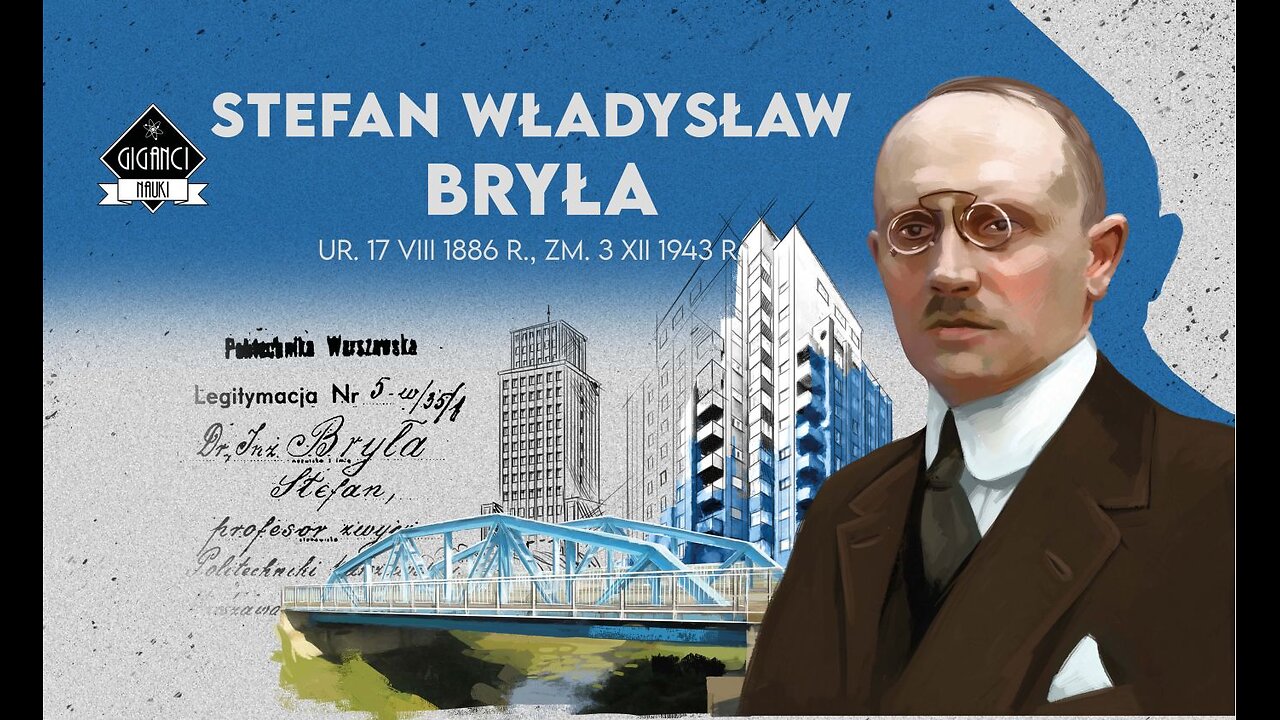Premium Only Content

𝐒𝐓𝐄𝐅𝐀𝐍 𝐁𝐑𝐘Ł𝐀 (1886-1943) – Giants of Polish Science
Prof. Stefan Bryła - the constructor of the Prudential skyscraper in Warsaw and a long-time MP of the #IIRP Seym, who fought for a free Poland during #WW2❗
👤 This outstanding Polish engineer authored a textbook "How to Destroy Steel Bridges" for the Home Army. At the same time he developed a 10-year plan for the post-war reconstruction of Poland and was the Dean of the clandestine Architecture Department of the Warsaw University of Technology. He was murdered by the Germans in 1943.
----------------------
▶ Did you know that Polish scientists authored the most famous inventions and breakthroughs which changed our lives ❓ We owe to Poles the foundations of modern electronics, the basic ingredient of artificial fertilizers, the most famous radiotelephone in the world - the walkie-talkie, a mine detector used by all armies in the world, the hydrogen bomb, the first lunar vehicle, or the hologram. These are the works of such giants of science as: Jan Czochralski, Ignacy Mościcki, Henryk Magnuski, Józef Kosacki, Mieczysław Bekker, Mieczysław Wolfke, AleksanderWasiutyński and many others - they changed the face of our civilization❗
📣 The Institute of the History of Science of the Polish Academy of Sciences and the Institute of National Remembrance bring back the memory of outstanding, and for the most part forgotten, Poles ⬇⬇⬇
📽 In 2021 - as part of the ‘Giants of Polish Science’ project – the IPNtv will present a series of documentary films 𝑮𝒓𝒆𝒂𝒕 𝑷𝒐𝒍𝒊𝒔𝒉 𝒊𝒏𝒗𝒆𝒏𝒕𝒐𝒓𝒔 𝒊𝒏 𝒕𝒉𝒆 𝑺𝒆𝒄𝒐𝒏𝒅 𝑷𝒐𝒍𝒊𝒔𝒉 𝑹𝒆𝒑𝒖𝒃𝒍𝒊𝒄 🇵🇱 directed by Alina Czerniakowska. Each episode is devoted to one of the figures whose scientific and technological achievements have made Poland world famous.
📚 Five volumes, over 2,400 pages containing 1,300 biographies (most of them compiled for the first time), and on top of that, a rich pool of source materials – that is, in short, what the unique dictionary of "Polish Contribution to Natural Science and Technology" is about. Published by the Institute of the History of Science of the Polish Academy of Sciences and the Institute of National Remembrance, it brings back the memory of outstanding, and for the most part forgotten, Poles.
-
 LIVE
LIVE
The Rubin Report
32 minutes agoPress Gasps When Told Trump’s Brutal Plan for Sanctuary Cities
2,710 watching -
 LIVE
LIVE
The White House
54 minutes agoPresident Trump Participates in a Bill Signing Ceremony, June 12, 2025
696 watching -
 LIVE
LIVE
Akademiks
36 minutes agoDiddy Trial Day 22: Jane Doe aka 50 Cent Baby Moms Cross Examine. ALLSTAR FREEKOFF Day 4/30
1,837 watching -
 1:01:12
1:01:12
VINCE
2 hours agoWhat Are They Trying To Distract Us From? | Episode 63 - 06/12/25
62.5K73 -
 LIVE
LIVE
LFA TV
11 hours agoLFA TV ALL DAY STREAM - THURSDAY 6/12/25
4,570 watching -
 LIVE
LIVE
Bannons War Room
3 months agoWarRoom Live
14,357 watching -
 LIVE
LIVE
Benny Johnson
1 hour agoTrump Speaking LIVE from White House Soon as LA Burns, Gavin Newsom PANIC | Massive Airliner Crash
7,502 watching -
 LIVE
LIVE
Discover Crypto
1 hour agoWAR SHOCK: Why Bitcoin Just Tanked (And What Comes Next)
116 watching -
 LIVE
LIVE
NEWSMAX
2 hours agoThe Gerry Callahan Show LIVE (06/12/2025) | NEWSMAX Podcasts
450 watching -
 LIVE
LIVE
The Big Mig™
2 hours agoMike Ritland, Former Navy SEAL & K9 Trainer, New York Times Bestselling Author
5,560 watching